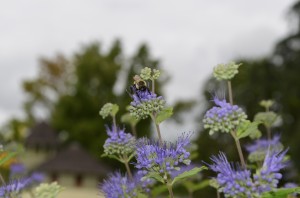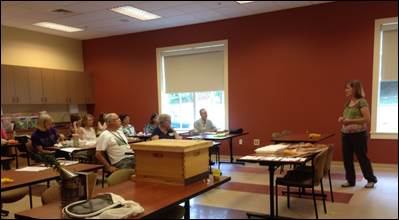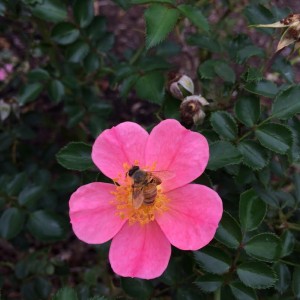The Significant Contributions of Bees
by Kristi Orcutt, Children’s Garden Educator, Lewis Ginter Botanical Garden 
What fascinated participants most was the myriad of ways that beekeepers use their hives as their own backyard medicine chests. While many of us know about honey’s antibacterial and antioxidant properties, some people believe that regular ingestion of local honey relieves their pollen allergy symptoms. Additionally, we talked about how beekeepers collect some of the pollen brought back to the hive by foraging bees and use that pollen as a high protein energy supplement and antioxidant. Another substance, propolis, a resin gathered from tree buds, is used by bees as an antiseptic. Bees coat the interior surfaces of their hive and use it as a caulk to seal cracks and spaces throughout. Propolis is also sometimes used by people to ease sore throats and to fight bacterial infections.
(Of course, if you are sick, please check with your doctor).
We talked about royal jelly too, a unique substance fed to queen bees and sometimes used by people as an energy tonic, to enhance endurance, and for healing. Some sufferers of arthritis, multiple sclerosis, Lyme disease and other ailments will intentionally sting themselves (apitherapy) and report that the anticoagulants and enzymes result in relief from chronic pain associated with these conditions.
We also discussed their worrisome decline. Virginia agriculture, our economy, and our food system depend on bees. Honey bees especially are a bio-indicator of the state of our ecosystem. The average rate of hive “loss” over the past several years in the United States and in Virginia is around 35 percent. Basically, over a third of our bees die each year….by any comparison, that is unsustainable as a business model for any farmer. Also suffering are produce farmers requiring the services of beekeepers to pollinate their crops. For the past 10 years, area farmers have found it difficult to hire enough hives to effectively pollinate their crops. When Colony Collapse Disorder (CCD) escalated about 10 years ago, compounded by financial losses due to hive deaths, and an aging beekeeper population, over a third of Virginia’s beekeepers left the industry. Fewer bees = lower produce yields = higher prices for produce and milk (dairy cows eat alfalfa…pollinated by bees). For people already experiencing food insecurity (our poorest Virginians), this will mean even less access to healthy diverse diets of fresh produce.
So think of honey bees as canaries in the coalmine. Our bees are “telling us” something by their disappearance….no one can point a finger at any single factor. Mites, a fungus, a new disease, pesticides, GMO crops are all suspect.
We know that one colony of bees covers an area of about 12,000 acres…bees are touching just about every flower in that area….and what they are “picking up” in the pollen, the nectar, and residues on the plants they visit…they bring home to the hive, secrete into their wax, raise their young surrounded by wax cells containing micro-particles of a myriad of chemicals (pesticides, herbicides, air pollutants, etc.) and about 3 generations later….(in bee time….one summer) the bees start to suffer the effects of bio-accumulation…and they succumb to mites and fungi and diseases that, as healthy bees, they should be able to overcome.
But there’s hope. We have some suggestions and The North American Pollinator Protection Campaign (NAPPC) does too.
The problem is multipronged….overuse of chemicals in our landscapes and fields (sprayed insecticides, plant grown from seeds treated with insecticides, herbicides, etc.) and simply not enough flowers for the bees are some of the problems. Plants along the roadside are sprayed and mowed, weeds are expunged from yards, weeds and wildflowers are now rounded-up around fields, crops are often designed to be “Roundup Ready”, and sometimes even flowers are toxic if their seeds were treated with insecticides that permeate the entire plant’s system.
So the solution is multi-pronged, too.
Local bee clubs are part of the solution…each year classes are offered to train new beekeepers. Keeping a hive or two of bees opens your eyes to a world of occurrences previously unnoticed….you’ll notice the array of native bees, take notice of what is blooming, and when observe the varieties of pollen colors that bees are gathering (this week it’s white!) Longer-term, it is hoped that some of these new beekeepers will be successful enough to offer pollination services to local farmers.
Other things we can do: plant more plants. Take care that plants and seeds you purchase are grown in nurseries without the use of pesticides. Tolerate a few weeds. Find alternatives to using chemicals. And, rather than spraying our yards, eliminate mosquitoes by carefully monitoring your landscape to eliminate hidden puddles of water that mosquitoes use to breed.
NAPPC and the United States Department of Agriculture (USDA) also suggest:
The best action the public can take to improve honey bee survival is not to use pesticides indiscriminately. In particular, the public should avoid applying pesticides during mid-day hours, when honey bees are most likely to be out foraging for nectar and pollen on flowering plants.
In addition, the public can plant pollinator-friendly plants—plants that are good sources of nectar and pollen such as red clover, foxglove, bee balm, joe-pye weed, and other native plants.

